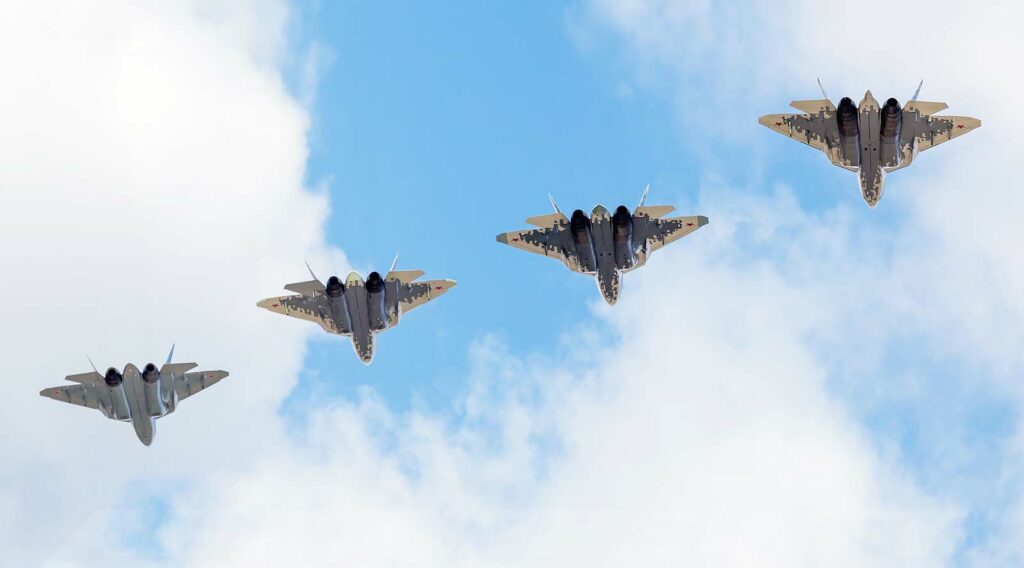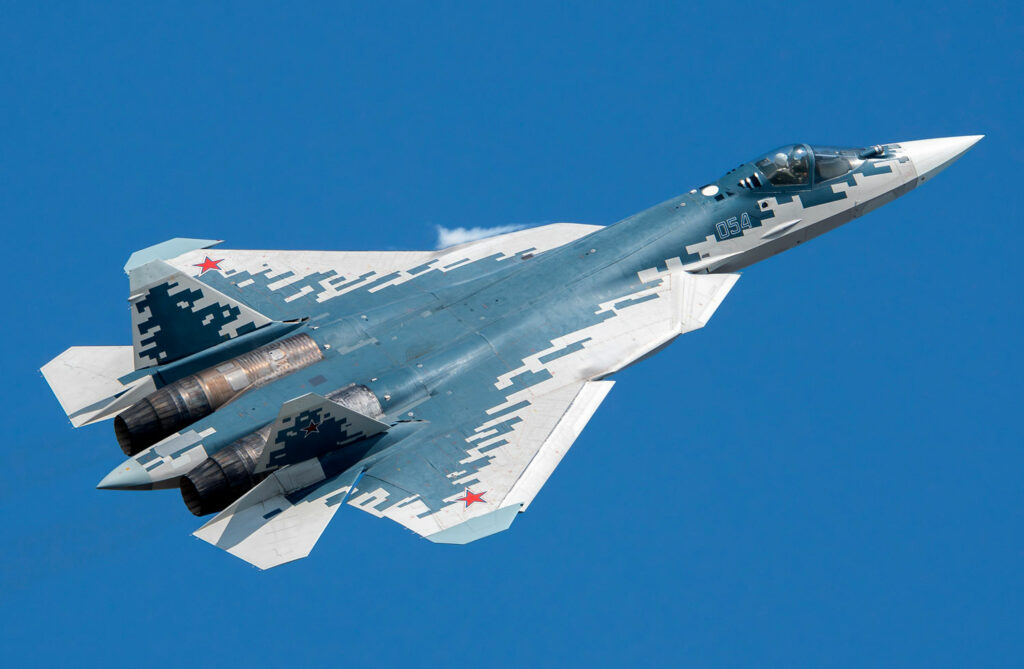The Sukhoi Su-57 is a Russian twin-engine, fifth-generation stealth multirole fighter aircraft designed for air superiority and attack operations.
The Sukhoi Su-57, designated by NATO as “Felon”, is a fifth-generation multirole fighter developed by Russia’s Sukhoi Design Bureau. It integrates stealth technology, supermaneuverability, advanced avionics, and substantial payload capacity. Powered by twin engines, the Su-57 achieves speeds up to Mach 2 and features supercruise capability at Mach 1.3. Its design includes internal weapon bays to reduce radar cross-section and thrust vectoring nozzles for enhanced agility. The aircraft is equipped with a sophisticated avionics suite, including an active electronically scanned array (AESA) radar, facilitating simultaneous engagement of multiple targets. With a range of approximately 3,500 km (2,200 miles) and a service ceiling of 20,000 meters (66,000 feet), the Su-57 is engineered to perform in both air superiority and ground attack roles, representing a significant advancement in Russian military aviation.
History of the Development of the Sukhoi Su-57 (Felon)
In the late 20th century, advancements in military aviation, particularly the development of fifth-generation fighter jets like the American F-22 Raptor, prompted Russia to pursue its own next-generation aircraft. The objective was to create a multirole fighter that combined stealth, supermaneuverability, and advanced avionics to ensure parity with potential adversaries.
The PAK FA (Perspektivny Aviatsionny Kompleks Frontovoy Aviatsii) program was initiated in 1999 to develop this advanced fighter. Sukhoi, a leading Russian aerospace company, was selected to lead the project, with the internal designation T-50 assigned to the prototype aircraft. The program aimed to produce a cost-effective and capable alternative to earlier, more expensive projects like the Mikoyan Project 1.44/1.42.
The T-50 prototype conducted its maiden flight on January 29, 2010, marking a significant milestone in Russian aviation. Over the subsequent years, the aircraft underwent extensive testing to validate its design, performance, and systems integration. In July 2017, the aircraft was officially named the Su-57. The NATO reporting name “Felon” was later assigned to the aircraft, following NATO’s convention of assigning code names to new military hardware.
The Su-57’s development was driven by the need to replace aging Soviet-era fighters and to counter advancements in Western military aviation. The aircraft was designed to perform a wide range of missions, including air superiority, ground attack, and reconnaissance, making it a versatile asset for the Russian Aerospace Forces.
Despite initial plans for rapid production, the Su-57 program faced several challenges, including technical issues and funding constraints, which delayed its entry into service. The first production aircraft was delivered to the Russian Aerospace Forces in December 2020. As of 2024, approximately 15 to 20 Su-57s are believed to be in frontline service, with plans to increase this number in the coming years.
The Su-57 has also been considered for export, with countries like Algeria expressing interest in acquiring the aircraft to modernize their air forces. However, as of now, no export contracts have been finalized.

Design of the Sukhoi Su-57 (Felon)
The Sukhoi Su-57 features a design that integrates stealth technology, aerodynamic efficiency, and advanced avionics to fulfill its multirole capabilities. The aircraft measures approximately 20.1 meters (65 feet 11 inches) in length, with a wingspan of 14.1 meters (46 feet 3 inches) and a height of 4.6 meters (15 feet 1 inch). The wing area is about 78.8 square meters (848 square feet), contributing to its agility and lift characteristics.
A key aspect of the Su-57’s design is its emphasis on reduced radar cross-section (RCS). The airframe incorporates radar-absorbing materials (RAM) and features a blended wing-body configuration with internal weapon bays, minimizing radar reflections. The aircraft’s angular surfaces and serrated edges further contribute to its stealth profile, enhancing its survivability in contested environments.
The Su-57 is equipped with twin Saturn AL-41F1 afterburning turbofan engines, each providing a dry thrust of 88.3 kN (19,900 lbf) and up to 142.2 kN (32,000 lbf) with afterburner. These engines feature thrust vectoring nozzles, granting the aircraft exceptional maneuverability, including the ability to perform advanced aerobatic maneuvers. The integration of thrust vectoring with the KSU-50 flight control system allows for precise handling and agility in various flight regimes.
The cockpit is designed to enhance pilot situational awareness, featuring a glass cockpit layout with large multifunction displays and a wide-angle head-up display (HUD). The avionics suite includes an active electronically scanned array (AESA) radar, providing the capability to detect and track multiple targets simultaneously.
The radar system, designated N036 Byelka, consists of multiple arrays, including the main nose-mounted radar and additional side-facing arrays. This setup provides the Su-57 with an exceptional field of view and the ability to engage targets in all directions. The aircraft also features advanced infrared search and track (IRST) systems for passive detection of heat-emitting targets, such as enemy aircraft and missiles.
The internal weapon bays enhance the aircraft’s stealth by housing a variety of munitions, including air-to-air missiles (AAMs), air-to-surface missiles (ASMs), and guided bombs. The bays can carry up to 4,000 kilograms (8,818 pounds) of ordnance. For missions requiring heavier payloads, the Su-57 can utilize external hardpoints, though this compromises its stealth profile.
The Su-57’s design incorporates modularity, allowing for upgrades and the integration of new systems over time. However, some drawbacks include the complexity of its systems and a higher maintenance requirement compared to earlier Russian fighters. Despite these challenges, the Su-57’s design embodies a balance between stealth, agility, and multirole functionality, making it a cornerstone of modern Russian airpower.
Performance of the Sukhoi Su-57 (Felon)
The Sukhoi Su-57 is powered by twin Saturn AL-41F1 afterburning turbofan engines, offering high thrust and efficiency. With these engines, the aircraft achieves a maximum speed of approximately Mach 2 (2,470 km/h or 1,535 mph) at altitude. The engines also provide supercruise capability, allowing sustained speeds of Mach 1.3 (1,600 km/h or 995 mph) without afterburners.
The Su-57 has an operational range of 3,500 kilometers (2,175 miles) without refueling and a ferry range of up to 5,500 kilometers (3,420 miles) with external tanks. Its service ceiling is 20,000 meters (65,617 feet), enabling operations at high altitudes beyond the reach of most ground-based threats.
The thrust vectoring nozzles give the Su-57 exceptional agility, allowing it to perform advanced maneuvers such as the Pugachev’s Cobra and tight turns, which are crucial in close-range dogfights. Combined with its aerodynamic design and advanced flight control systems, the Su-57 is one of the most maneuverable aircraft in its class.
The N036 Byelka radar system, with a detection range of up to 400 kilometers (248 miles), enhances the Su-57’s situational awareness. The radar can track multiple targets simultaneously, including stealth aircraft, and direct missiles using datalink guidance.
The aircraft’s payload capacity is approximately 10,000 kilograms (22,046 pounds), distributed between internal weapon bays and external hardpoints. Standard armament includes R-77 and R-74 air-to-air missiles, Kh-38 and Kh-59 air-to-surface missiles, and precision-guided bombs. The Su-57 is also equipped with a 30mm GSh-30-1 autocannon, effective for close-range engagements.
Compared to Western fifth-generation fighters like the F-22 Raptor and F-35 Lightning II, the Su-57 excels in maneuverability and payload capacity. However, its stealth capabilities are considered inferior due to a larger radar cross-section and less mature RAM technology. Additionally, the Su-57 has faced delays in adopting its next-generation Izdeliye 30 engines, which are expected to enhance performance further.
In operational scenarios, the Su-57 is designed to operate as a multirole platform, capable of engaging both aerial and ground targets with precision. Its performance characteristics make it a formidable competitor in modern air combat, particularly in regions with contested airspace.
Variants of the Sukhoi Su-57 (Felon)
- Su-57 Baseline Variant:
This is the standard production model, equipped with the Saturn AL-41F1 engines and a complete suite of avionics and sensors. It is designed for multirole operations, including air superiority and ground attack. - Su-57M:
A modernized variant under development, featuring the Izdeliye 30 engines, enhanced stealth features, and upgraded avionics. This version is expected to enter service in the late 2020s. - Su-57 Export Variant:
Dubbed Su-57E, this version is tailored for export customers, with modifications to comply with international regulations. Potential buyers include Algeria and India, though no confirmed sales have been made. - Unmanned Variant:
Reports indicate ongoing development of an unmanned or optionally piloted version of the Su-57, leveraging advanced artificial intelligence for autonomous operations. This variant remains conceptual as of 2025.

Military Use and Combat of the Sukhoi Su-57 (Felon)
The Su-57 is designed to perform a variety of missions, ranging from air superiority and ground attack to reconnaissance and electronic warfare. Its deployment in the Russian Aerospace Forces began in 2020, with the aircraft undergoing integration into frontline units.
Armament and Capabilities
The Su-57’s armament includes a mix of air-to-air and air-to-ground munitions. Key weapons include:
- R-77-1 air-to-air missiles: Medium-range radar-guided missiles for beyond-visual-range engagements.
- R-74M short-range missiles: Infrared-guided missiles optimized for dogfights.
- Kh-59MK2 cruise missiles: Precision-strike weapons for ground targets.
- FAB-series bombs: Conventional and guided variants for high-precision bombing.
The aircraft’s 30mm GSh-30-1 cannon provides additional versatility in close-range engagements.
Combat Use
The Su-57 saw limited deployment during Russia’s military operations in Syria, where it was used for live-fire testing of its weapons and systems. Reports indicate that it conducted precision strikes on ground targets, demonstrating its multirole capabilities. While these missions provided valuable operational data, the Su-57’s role was primarily experimental.
Competing Aircraft
The Su-57 competes with Western fifth-generation fighters like the F-22 Raptor and F-35 Lightning II, as well as China’s J-20. While it outperforms the F-35 in terms of speed and maneuverability, it lags behind the F-22 and J-20 in stealth.
Export Prospects
Despite interest from nations like India and Algeria, export efforts have been slow due to geopolitical factors and the aircraft’s high cost. The Su-57E variant aims to address these challenges by offering a more affordable and customizable platform for international buyers.
Future Prospects
The Su-57 remains a critical part of Russia’s modernization efforts. With ongoing upgrades, including the integration of the Izdeliye 30 engines and advanced avionics, the aircraft is expected to enhance its operational capabilities. However, its success will depend on overcoming production challenges and securing export contracts to ensure sustainability.
The Sukhoi Su-57 represents Russia’s effort to compete in the fifth-generation fighter domain. Its combination of agility, multirole functionality, and advanced avionics positions it as a versatile platform for modern combat. While its stealth capabilities lag behind Western counterparts, its emphasis on supermaneuverability and payload flexibility ensures its relevance in a variety of operational contexts. Ongoing upgrades will further solidify its role in Russia’s military aviation strategy.
Back to the Fighter Jet section.